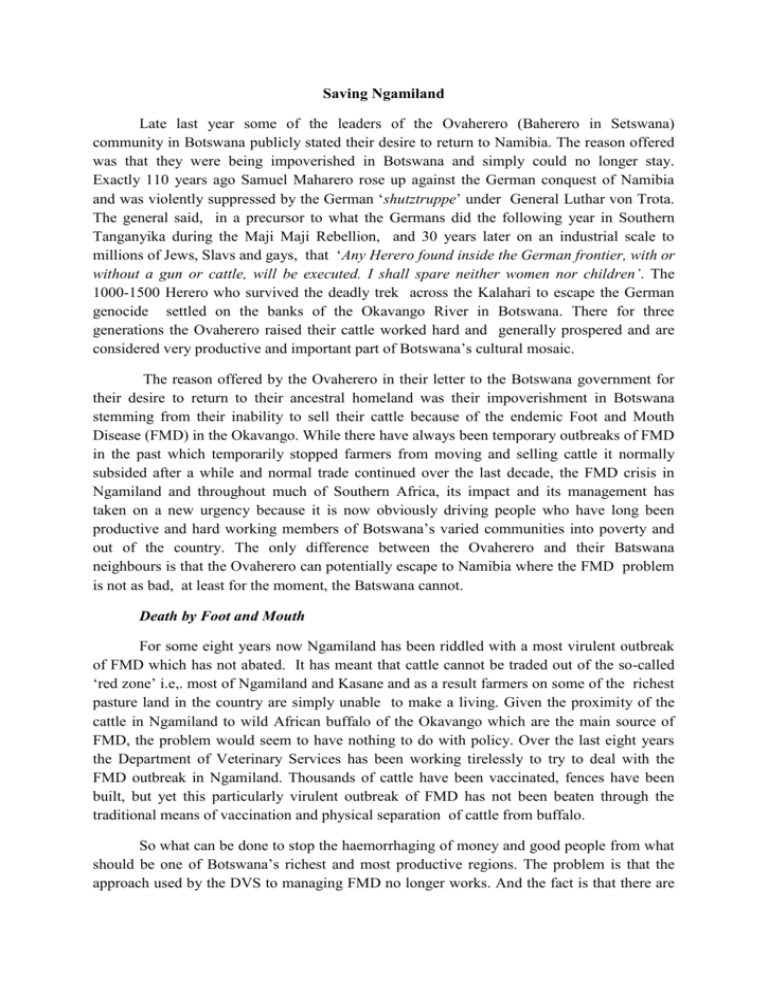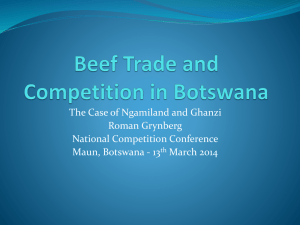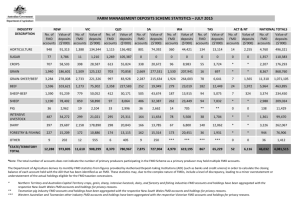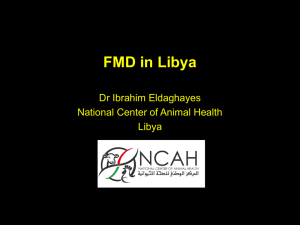Saving Ngamiland - Competition Authority
advertisement

Saving Ngamiland Late last year some of the leaders of the Ovaherero (Baherero in Setswana) community in Botswana publicly stated their desire to return to Namibia. The reason offered was that they were being impoverished in Botswana and simply could no longer stay. Exactly 110 years ago Samuel Maharero rose up against the German conquest of Namibia and was violently suppressed by the German ‘shutztruppe’ under General Luthar von Trota. The general said, in a precursor to what the Germans did the following year in Southern Tanganyika during the Maji Maji Rebellion, and 30 years later on an industrial scale to millions of Jews, Slavs and gays, that ‘Any Herero found inside the German frontier, with or without a gun or cattle, will be executed. I shall spare neither women nor children’. The 1000-1500 Herero who survived the deadly trek across the Kalahari to escape the German genocide settled on the banks of the Okavango River in Botswana. There for three generations the Ovaherero raised their cattle worked hard and generally prospered and are considered very productive and important part of Botswana’s cultural mosaic. The reason offered by the Ovaherero in their letter to the Botswana government for their desire to return to their ancestral homeland was their impoverishment in Botswana stemming from their inability to sell their cattle because of the endemic Foot and Mouth Disease (FMD) in the Okavango. While there have always been temporary outbreaks of FMD in the past which temporarily stopped farmers from moving and selling cattle it normally subsided after a while and normal trade continued over the last decade, the FMD crisis in Ngamiland and throughout much of Southern Africa, its impact and its management has taken on a new urgency because it is now obviously driving people who have long been productive and hard working members of Botswana’s varied communities into poverty and out of the country. The only difference between the Ovaherero and their Batswana neighbours is that the Ovaherero can potentially escape to Namibia where the FMD problem is not as bad, at least for the moment, the Batswana cannot. Death by Foot and Mouth For some eight years now Ngamiland has been riddled with a most virulent outbreak of FMD which has not abated. It has meant that cattle cannot be traded out of the so-called ‘red zone’ i.e,. most of Ngamiland and Kasane and as a result farmers on some of the richest pasture land in the country are simply unable to make a living. Given the proximity of the cattle in Ngamiland to wild African buffalo of the Okavango which are the main source of FMD, the problem would seem to have nothing to do with policy. Over the last eight years the Department of Veterinary Services has been working tirelessly to try to deal with the FMD outbreak in Ngamiland. Thousands of cattle have been vaccinated, fences have been built, but yet this particularly virulent outbreak of FMD has not been beaten through the traditional means of vaccination and physical separation of cattle from buffalo. So what can be done to stop the haemorrhaging of money and good people from what should be one of Botswana’s richest and most productive regions. The problem is that the approach used by the DVS to managing FMD no longer works. And the fact is that there are ways of dealing with the effects of FMD . For years Botswana has abided by the standards of World Animal Health Organization (called the OIE) as found in the Terrestrial Code. In that code the generally recognized means of dealing with FMD is the one accepted here and taught to every one of Botswana’s vets – inoculate and geographically separate the cattle and if the inoculation is not working or the separation is not effective then just build more fences and give more injections. But here is actually nothing wrong with eating meat from cattle from an FMD area, as long as it is treated properly. It is possible to prepare the meat properly in an abattoir to minimize risk. This approach is based on what is called ‘commodity based trade’ and is accepted a supported by the UN’s Food and Agricultural Organization (FAO). Dealing with beef from FMD areas involves a number of important procedures. These include appropriate vaccination against FMD along with mechanized transportation of cattle. Once the cattle are slaughtered the carcass temperature needs to be kept at a ceratin level, the meat has to be deboned and lymph nodes removed. The meat has to be matured to a point where the pH level is appropriate. Once these measures are implemented then the meat is perfectly safe for human consumption as long as conventional food safety measures are adhered to. Nice Idea but why aren’t we doing it? This raises the obvious question of, if Commodity Based trade is so effective why has it not been implemented? Those who set policy in our two main markets are either completely opposed to it as in the case of Europe or are quietly saying they support it but doing nothing to actually help countries sell beef into South Africa. The EU is so unreasonable that only does it require beef to be FMD free it also requires deboning and maturation as a condition for export. So we not only have to prove the Europeans that not does our beef come from FMD areas but we must also implement all the non-geographic measures as well. South Africa, which would much prefer to ‘beneficiate’ i.e. fatten Botswana’s weaners and certainly not buy our beef is like the rest of us. South Africa talks the talk about non-geographic ways of controlling FMD and was a party to SADC’s Phakalane Declaration supporting commodity based trade. But question the authorities in Pretoria about what measures they have put in place to facilitate trade from countries that wish to use CBT and they will tell you nothing, if they are honest. A commercial rat But the South Africans are really no worse than Botswana’s DVS or the equivalent in Namibia. They were all trained by the same (usually South African and European) professors who have told them that the tried and tested way to deal with FMD is through separation and inoculation. They also all have the same protectionist interests. Changing to commodity based trade which emphasizes food safety means unlearning what their professors taught them at Veterinary school. It takes a particularly independent person to do that. But at the very core of the problem lies commercial interests. Everyone knows that such a system would save Ngamiland from the scourge of FMD but there is the foul smell of a commercial rat in all this. In Africa only two countries, parts of Namibia and Botswana, are able to export chilled or frozen beef. Everyone wants to protect their country’s farmers and if you accept beef trade based on the new commodity based approach countries with endemic FMD which are currently banned from trading e..g. Tanzania and Ethiopia but have massive herds will soon be selling beef in a supermarket near you at prices that would help the consumer but not your local beef farmer. It is this commercial rat in the scientific ointment that explains reason why there been no change and why the vets will talk the talk but need to be pushed by the politicians to walk the talk. How do we do this in Ngamiland ? So what good would it do Ngamiland if we went to commodity based trade if the two main markets for our beef ie the EU and South Africa are not likely to accept them even if we move over to it. The proponents of commodity based trade argue that the solution lies in part in using these new commodity based approaches to have Ngamiland supply Botswana with beef and have all the beef from the green zones supplying the EU and South Africa. The only problem is that under current rules we cannot transport Ngamiland beef into the rest of the country. If we could this it would provide an immediate safety valve for the commercial catastrophe in Ngamiland. The way to proceed would be to do exactly what Namibia has started doing in the Caprivi Strip which has similar FMD problems to Ngamiland and that is to undertake a risk assessment of moving beef from the Caprivi strip south. The only problem with this approach is commercial. The CBT approach involves deboning beef which has a limited market in Botswana and throughout Southern Africa. Zimbabwe which used to have amongst the best FMD controls in Southern Africa watched them collapse over the period of its economic crises. They are now the first country to abandon the geographic approach and have moved over to commodity based trade. They have been rewarded by sales to Angola based on CBT and not on geographic controls. It is time for DVS to implement policies for the benefit of Ngamiland based on CBT and finding markets that will accept it – outside the normal box. These are the views of Professor Roman Grynberg and not necessarily those of the Botswana Institute for Development Policy analysis where he is employed.



